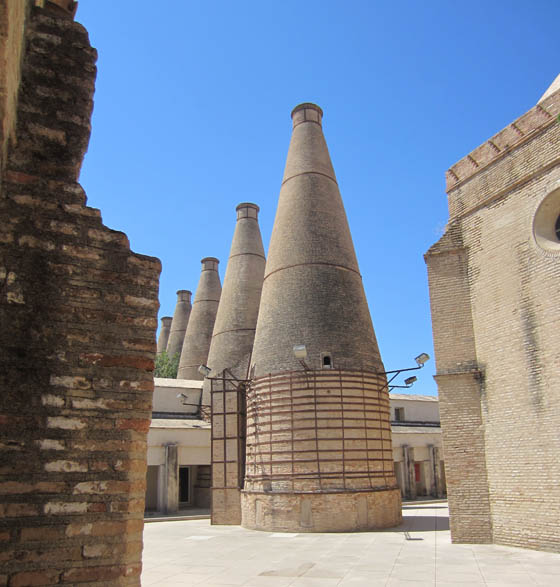Some of my recent posts have been all about the special exhibit at the Center for Contemporary Art here in Sevilla. You may remember that the property was originally a monastery built in the year 1400. Gardens, separate chapels, and other structures were added over the centuries that followed. And then, in the mid-1800s, the property was purchased by a Brit and a major ceramics factory was built amid the existing structures. Finally, in the late 20th century, it became the Centro Andaluz de Arte Contemporáneo (Andalusian Center for Contemporary Art). Mostly gardens and structures this post… with just a tiny bit of art thrown in for good measure.
 |
| 19TH-CENTURY FIRING OVENS (BRITISH STYLE). |
 |
ONE OF THE OVENS WITHIN A CONTEMPORARY GALLERY… AND WITHOUT.
(ADELA IN BACKGROUND BROWSING THE EXHIBIT.) |
 |
| THE CLAUSTRILLO (“LITTLE CLOISTER”). BUILT IN THE SECOND HALF OF THE 15TH CENTURY. |
 |
CHAPTER HOUSE, INTENDED FOR THE MONKS’ MOST IMPORTANT MEETINGS.
CEDED AS BURIAL VAULT OF RIBERA FAMILY, MONASTERY PATRONS.
IT WAS A CARPENTRY WORKSHOP DURING FACTORY PERIOD (BODIES WERE MOVED OUT). |
 |
| PART OF THE INTERIOR “SKYLINE.” |
 |
THE 16TH CENTURY CHAPEL OF SANTA JUSTA AND SANTA RUFINA.
(REMADE INTO A GARDEN PAVILION DURING THE FACTORY PERIOD.) |
 |
| ARTWORK: THE “BLACK PEARL” CURTAIN COVERING CHAPEL ENTRIES. |
 |
IT CREATES A WONDERFUL EFFECT FOR VIEWING MY FRIENDS.
(UNFORTUNATELY, IT’S MADE OF BLACK PLASTIC BEADS; NOT REAL PEARLS.) |
 |
| THE BACK OF THE CHAPEL/GARDEN PAVILION. |
 |
ALMONDS ON A TREE.
NEAR A LARGE ORANGE ORCHARD (BITTER ORANGES FOR MARMALADE). |
 |
TOWER AND TWO (DECEASED) WATER WHEELS THAT USED TO PROVIDE WATER TO GARDENS.
THE GARDENS ARE IN NEED OF AN INFUSION OF MONEY. |
 |
SADLY, THE WATER WHEELS WEREN’T THE ONLY THINGS DECEASED THAT DAY.
(TWO MOURNING DOVES FLOATING IN THE STAGNANT WATER.)
SEVILLA’S NEW 40-STORY OFFICE TOWER RISING IN DISTANCE. |
 |
THE TREE, HERB, OR PLANT CALLED PHYTOLACCA DIOICA OR, SIMPLY, OMBU.
THOUGHT TO HAVE BEEN PLANTED BY THE SON OF CHRISTOPHER COLUMBUS
(WHEN COLUMBUS’S REMAINS WERE KEPT AT THE MONASTERY).
ITS TOXIC SAP MAKES IT IMMUNE TO INSECTS. |
Like this:
Like Loading...
Related
Author: Moving with Mitchell
From Brooklyn, New York; to North Massapequa; back to Brooklyn; Brockport, New York; back to Brooklyn... To Boston, Massachusetts, where I met Jerry... To Marina del Rey, California; Washington, DC; New Haven and Guilford, Connecticut; San Diego, San Francisco, Palm Springs, and Santa Barbara, California; Las Vegas, Nevada; Irvine, California; Sevilla, Spain. And Fuengirola, Málaga..
View all posts by Moving with Mitchell














it really steals your breath…so beautiful. That first pic looks like something out of Dune. and the black pearl curtain pic, amazing.
Once again you take us to the best places Mr B 😉
Monkey Man:
And thank you always for coming along!
Your pictures make me want to dash back to Spain. So beautiful, and the sunshine is wonderful.
Stephen:
We certainly have had our share of sunshine (and everyone else's apparently)!
Again… wonderful photos! So much to enjoy…. or maybe to look forward to? Loving all your posts!
The Odd Essay:
To look forward to! Thanks!
Love the 'pearl' curtain photo Mitch!
What a place! So much to see and learn. Those firing ovens are huge!! Loved this!
Jim:
The pearl curtain was really magical. Such a simple idea. The ceramics ovens are based on traditional English design. They now really identify the "skyline" of the factory from a distance.
That little chapel is a jewel. Tell us more (a future post?) about the new office building.
Walt the Fourth:
Thanks, as always, for your interest. I'll take a walk over one day and will get more pictures of the entire structure!
Hello Mitch:
The different architectural styles are so intriguing in this most fascinating of places. And we think that it is a triumph how the various buildings have been put to new and exciting uses. The plantings have also created a very special ambience, just perfect for spending time leisurely walking around and viewing the galleries.
Jane and Lance:
Mudejar design here makes for some really stunning and unusual architecture.
There are so many grand gardens in Sevilla, I'll never run out of places to walk.
Such lovely pictures. I wonder if the black pearl curtain had a practical purpose (discouraging insects?) as well as an aesthetic one. And I hope an "infusion of money" will be coming soon for these gardens!
Kristi:
In general, the beaded curtains ARE intended to stop insects, block some of the harsh sun, and provide a suggestion of privacy. I don't think that was the intention here. (And when I stayed in Italy in the '70s, I noticed their tiny mosquitoes were undaunted by a little bit of beading!)
I don't think money will be pouring in any time soon. So, I'll just have to keep visiting the museum and contributing my 1.30 euros!
We call 'em museums here, but from the looks of your photos, they are just every other building.
Or every building.
I want a black pearl curtain!!
Bob:
Museos here usually (as I know you already know). I'm sure you can find a black "pearl" curtain on ebay.
What a rich legacy Sevilla has. Those huge ceramic ovens could be art pieces on their own. I'm going to have to google the Ombu to learn more about why it's not considered a tree! Another fascinating post!
Ms. Sparrow:
According to the Center's brochure, it's not a tree. But according to what I read on the web, that statement is open for debate. It is descended from herbaceous ancestors and its trunk doesn't consist of true wood. It's sometimes called a tree, other times an herb, and other times a plant. I'll update the post to be a bit more clear (now that I've done a little reading… a little late).